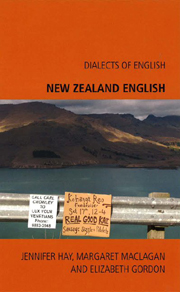Book contents
- Frontmatter
- Contents
- Preface
- Maps
- 1 Geography, Demography and Cultural Factors
- 2 Phonetics and Phonology
- 3 Morphosyntax
- 4 New Zealand Vocabulary and Discourse Features
- 5 The Origins of New Zealand English
- 6 Variation within New Zealand
- 7 Selected Bibliography of Works on New Zealand English
- 8 Sample Texts
- Bibliography of Cited Works
- Index
5 - The Origins of New Zealand English
Published online by Cambridge University Press: 12 September 2012
- Frontmatter
- Contents
- Preface
- Maps
- 1 Geography, Demography and Cultural Factors
- 2 Phonetics and Phonology
- 3 Morphosyntax
- 4 New Zealand Vocabulary and Discourse Features
- 5 The Origins of New Zealand English
- 6 Variation within New Zealand
- 7 Selected Bibliography of Works on New Zealand English
- 8 Sample Texts
- Bibliography of Cited Works
- Index
Summary
The European settlement of New Zealand is usually dated from 1840 which was the year that Maori and Europeans signed the Treaty of Waitangi. New Zealand English, therefore, has developed and evolved over a period of about 150 years. The date is significant because the beginning of European settlement in New Zealand is recent enough for the early stages of New Zealand English to be studied in a way which was impossible for those studying other earlier varieties of native-speaker English, such as American English or Australian English.
When people first recognised a new variety of English in New Zealand they said it came from the Cockney dialect of London. Later some suggested that New Zealand English was a dialect of Australian English. More recently, these explanations involving language transportation have been replaced by theories of new dialect development within the country itself.
New Zealand English and Cockney
New Zealand English was first recognised around 1900, when people all over New Zealand began to complain that children were speaking with a ‘colonial twang’. The most common explanation at that time was that it was a transported version of the London dialect of English known as Cockney. If it wasn't this, then at least it was very much influenced by Cockney. One of the first commentators on the pronunciation used in New Zealand in the late nineteenth century was a Scottish singing teacher called Samuel McBurney who had taught himself to use an early phonetic system. He wrote down interesting pronunciations that he heard as he travelled around Australia and New Zealand.
- Type
- Chapter
- Information
- New Zealand English , pp. 84 - 94Publisher: Edinburgh University PressPrint publication year: 2008



